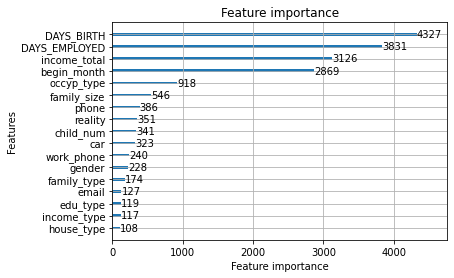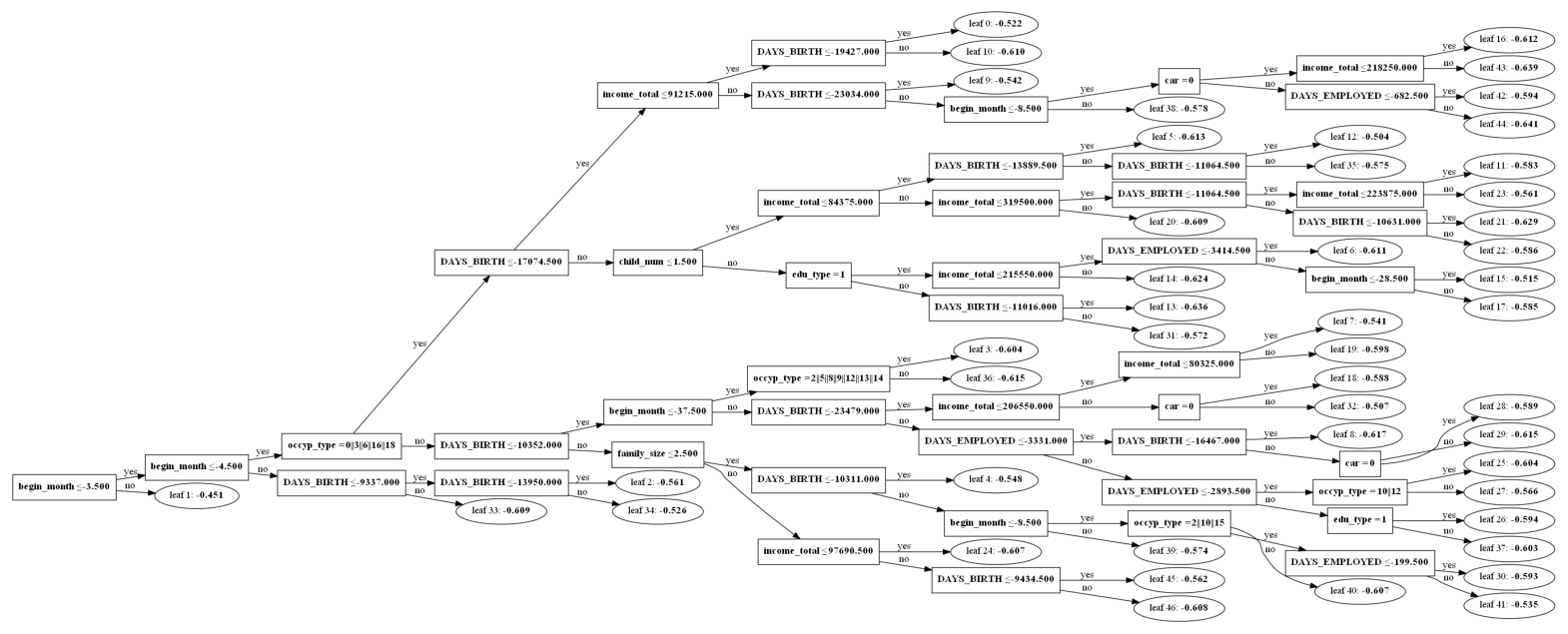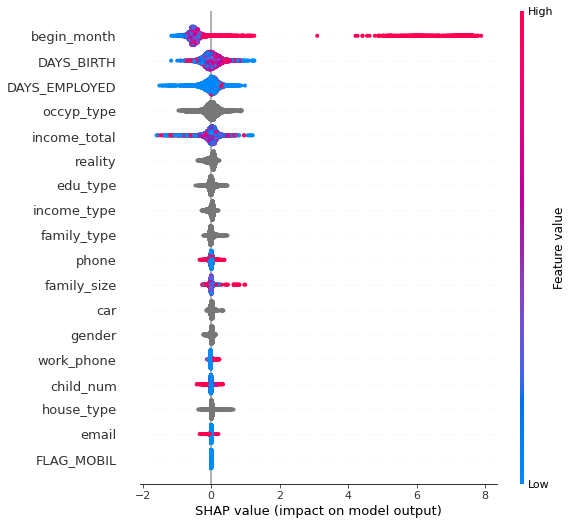Introduction
Credit card companies use personal information and data submitted by credit card applicants to calculate credit scores.
They use this credit score to predict the applicant’s likelihood of defaulting on future payments and delinquent credit card payments.
In this project, we develop an algorithm that can predict the degree of delinquency of a user’s credit card payment using personal information data of credit card users.
Experiment
1. Data Preparation
1.1. Data Exploration
There are 20 columns including index and credit(dependent variable).
| Feautre | Format | Description |
|---|---|---|
| index | ||
| gender | object | M: Male / F: Female |
| car | object | have car or not(Y/N) |
| reality | object | have reality or not(Y/N) |
| child_num | integer | number of children |
| income_total | float(0.0) | annual income |
| income_type | object | Commercial associate, Working, State servant, Pensioner, Student |
| edu_type | object | Higher education, Secondary / secondary special, Incomplete higher, Lower secondary, Academic degree |
| family_type | object | Married, Civil marriage, Separated, Single / not married, Widow |
| house_type | object | Municipal apartment, House / apartment, With parents, Co-op apartment, Rented apartment, Office apartment |
| DAYS_BIRTH | integer | interval between data collection date and birth date(negative number) |
| DAYS_EMPLOYED | integer | interval between data collection date and first working date(negative number) |
| FLAG_MOBIL | integer | have cell phone or not(1/0) |
| work_phone | integer | have business cell phone or not(1/0) |
| phone | integer | have phone or not(1/0) |
| integer | have email or not(1/0) | |
| occyp_type | object | type of occupation(NaN) |
| family_size | float(0.0) | number of family member |
| begin_month | float(0.0) | interval between data collection date and card issue date(negative number) |
| credit | float(0.0) | credit card delinquency level(lower credit means better user |
1.2. Data Preprocessing
I need to drop unusable variable(index) and fill NaN cells with None.
I then simplify the dependent variable by redefining the 3 levels of credit to 2 levels.(float → category)
1
2
3
df.drop(columns=['index'], inplace=True) # df: pandas dataframe of credit card data
df['occyp_type'] = df['occyp_type'].fillna('None')
df['credit'] = df['credit'].map(lambda x: 'low_risk' if x<=1.0 else 'high risk').astype('category')
Since categorical variables cannot be used in LightGBM, the category data type must be converted to object.
1
2
cat_vars = list(df.select_dtypes('object').columns)
df[cat_vars] = df[cat_vars].astype('category')
2. Model Fitting
2.1. Model Optimization
First, the data set is divided into independent and dependent variables, and then divided into train and test data in a ratio of 7:3 in a fixed random state 2021.
1
2
3
y = df['credit']
x = df.drop(columns=['credit'])
x_train, x_test, y_train, y_test = train_test_split(x, y, test_size=0.3, random_state=2021)
Next, the model parameters are optimized using the 5-fold algorithm with the train data./ The evaluation indicator at this project is logloss.
1
2
3
4
5
6
7
8
9
10
11
12
13
14
15
16
17
18
19
20
21
22
23
24
25
26
27
28
29
# Evaluation Indicator
logloss_ = make_scorer(log_loss, greater_is_better=False, needs_proba=True)
# LightGBM
warnings.filterwarnings("ignore")
md_lgb = LGBMClassifier(random_state=2021, categorical_feature=cat_vars)
# Parameter Optimization
params_lgb = {
'learning_rate':[0.05, 0.1, 0.15],
'n_estimators':[100, 200, 300, 400],
'max_depth':[5, 6, 7, 8, 9],
'num_leaves':[31, 47, 63],
'reg_alpha':[0, 1],
'reg_lambda':[0, 1, 10]
}
grid_search_lgb = RandomizedSearchCV(estimator=md_lgb,
param_distributions=params_lgb,
n_iter=10,
cv=5,
scoring=logloss_,
random_state=2021)
grid_search_lgb.fit(x_train, y_train, categorical_feature=cat_vars)
# Show Result
print(grid_search_lgb.best_params_)
print(grid_search_lgb.best_score_)
The result be like this.
- {‘reg_lambda’: 1, ‘reg_alpha’: 0, ‘num_leaves’: 47, ‘n_estimators’: 400, ‘max_depth’: 9, ‘learning_rate’: 0.05}
- -0.5505740190402201
Using these parameters, the model can be optimized.
1
2
3
4
5
6
7
8
9
10
11
# Model Optimization
md_lgb_best = LGBMClassifier(random_state=2021,
reg_lambda=1,
num_leaves=47,
max_depth=9,
learning_rate=0.05)
md_lgb_best.fit(x_train, y_train,
categorical_feature=cat_vars,
eval_set=[(x_test, y_test)],
early_stopping_rounds=10)
2.2. Model Evaluation
1
log_loss(y_test, md_lgb_best.predict_proba(x_test))
- 0.552121430722158
3. Conclusion
The importance of variables in the model is as follows.
1
2
plot_importance(md_lgb_best)
plt.show()
This is the visualized appearance of tree 0.
1
2
plot_tree(md_lgb_best, tree_index=0, dpi=100, figsize(20,12))
plt.show()
Next, calculate SHAP and look at the SHAP distribution for each variable.
1
2
3
4
explainer = shap.TreeExplainer(md_lgb_best)
shap_values = explainer.shap_values(x_test)
shap.initjs()
shap.summary_plot(shap_values[1], x_test, feature_names = x_test.columns)








